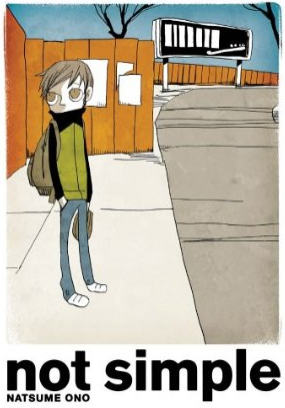
A story within a story, a book within a book, a tale about the search for family, for an emotional home.
Ian is a young man from Australia whose early life is filled with pain and heartbreak. His family life has always been troubled, with his distant father and his alcoholic mother, which is worsened when his sister, one of the few good things in his life, goes away without warning. He travels across several continents to find his sister and make a better life for himself. He is irregularly accompanied by Jim, a reporter who had initially written a story about Ian in a running competition and is interested in Ian's life story as the basis of a book. Through its backwards narrative, Ian's story shows that nothing is what it seems and that even the life of a nobody can turn out to be not simple.
Overall:
The manga not simple is, for lack of a better phrase, not simple. It has a narrative stream that is very wibbley-wobbley timey-wimey in that it starts at the end then slowly goes backward until it reaches that point at the beginning, only in such a way that once you finish you'll feel obligated to re-read the whole thing just to catch all the subtle hints and nuances in the storytelling. The plot is also not as straightforward as it seems: Is it a young boy's travels through childhood and adolescence? The story of two siblings growing together and then coming apart? A man's obsession with the star of his soon-to-be written novel based on a true story? The many different strands of character histories weave together to create a multifaceted story rarely found in many one-volume manga.
And then there is the art. Even though the simplistic style of Natsume Ono's artwork adds to the atmosphere of the story, and anything fancier would only detract from the narrative, the very unique style is still a drawback: it turns off the casual reader from picking it up and giving it a try. The cover itself can look childish to someone unfamiliar with the work, and may be passed over for books with more traditionally beautiful designs. This is a great tragedy in itself, but it cannot be helped. For those who choose to forego their brief misgivings about its looks and decide to actually read the book, they will find that under an art so simple is a story that is the exact opposite. A combination of Ono's unique line work and a deft hand at paneling makes each page a rewarding visual experience.
At the center of the book is Ian, a young man who is looking for his older sister, the only person he has ever depended on and truly loved in his life. He has been abused both emotionally and physically, isn't even one hundred percent sure what his true family history is, and is usually mistaken by strangers as a homeless bum by the way he dresses and acts. On the other side of this is Jim, a morose writer who has dreams of becoming a big deal in New York. He can't stand to be around his family despite the fact they they want to bring him back into the fold, and is constantly pushing them away. And yet he befriends Ian, who has spent almost his entire life looking for "the warmth of the people who should be closest to (him)", his family — a father who doesn't care, a sister who cares too much, and a mother who hates him completely. When these two stories clash, it is the resounding impact that will stick with readers long after the book is closed and tucked away on their shelves. However, it won't stay there long, as that is the beauty of not simple: as soon as you're done, you'll want to re-read it. And then, as soon as you've re-read it, you'll realize you want to read it over again. This is the greatest praise a manga can receive: it is re-readable and still enjoyable no matter what.
ComicsOnline gives not simple 4.5 out of 5 miles left to run.





